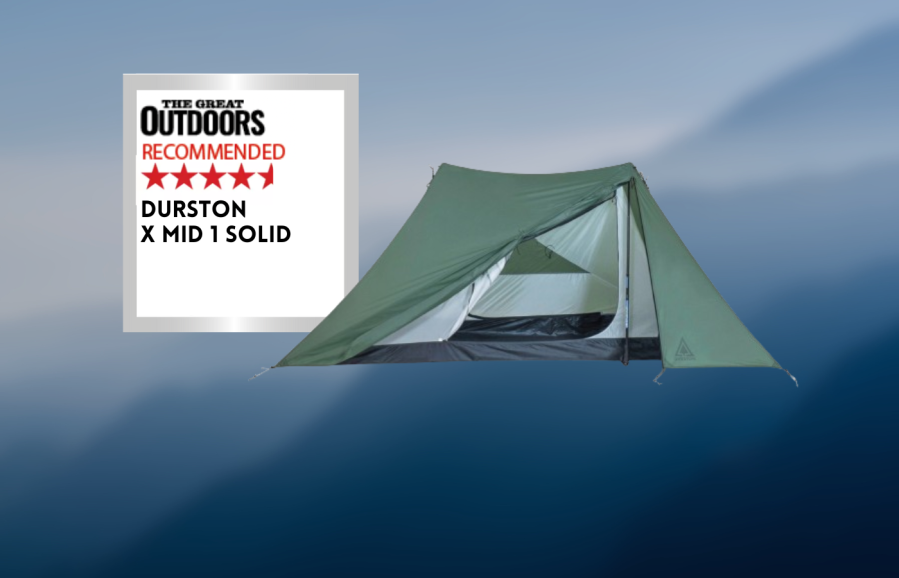The Durston Xmid shelters have quickly become a firm favourite in the lightweight backpacking and trekking world. Does the hype stack up? If you’re wanting the spoiler, my answer is that by and large, it does.
The X mid uses an offset design, which maximizes living space exceptionally well. This means the inner sits at an angle to the fly. It’s not the only tent to do this (Sierra Designs have a similar style tent in the High Route) but it does create 2 large storage areas, to the left of each door, which can be used to store wet gear and to cook.
David Lintern Recommends
Overall, The X mid 1 is a really spacious, comfortable tent. The substantial poly’ fly gives peace of mind in the wet, and the offset guylines provide lots of stability in windy conditions.- Versatility
- Weight
- Space
- Side entry design can let rain into the inner
| Quick specs | |
|---|---|
| Price: $280 USD or £230 plus import tax = £309 Weight: 955g (825g without extra guys, 974g with, stakes 130g) Pitching: As a unit, or outer first Flysheet: 20D Sil/PE Polyester, 3500mm Hydrostatic Head Inner: 15D Ripstop Nylon in White, mesh panels. Groundsheet: 20D Sil/PE Polyester 3500mm Hydrostatic Head Poles: Not supplied – uses trekking poles Pegs: 4 x 6″ (8.5 g ea) and 4 x 7″ (12 g ea) Porches: 2 Inner Dimensions: 81cm w, 2.3m long, 117cm tall durstongear.com |
It’ll pitch outer first (better for wet weather), or as a complete unit, the basic pitch requiring 4 pegs and 2 trekking poles. It also comes with an additional guyline at each end, to tension the poles. I’d have liked to see a coloured guyline used (the black is invisible in the dark) but the line is strong.
In this factory configuration, it’s surprisingly weather worthy. I added extra guys on both side panels and extras at the base x 4. On my extended test in the Alps, my additions proved overkill for all except the last few days, when the ones at the base were useful to stop the sides blowing in. I found additional side panel guys useful for keep a door ‘ajar’ in stormy Scottish weather subsequently, but most of the time, it’s very stable as it is.
The fly can be pitched on its own for more internal space (you might just squeeze 2 people in, adventure race style), but in bug season the inner clips in very neatly. The poles are tucked away from each entrance. The doors are large for ease of access, but as with many side entry tent designs, this does mean wind driven rain can enter the inner. There are two doors, though, so you have a choice of which to use.
As the name suggests, the X mid solid features a solid inner for additional warmth. This has 2 mesh windows, but no pockets. There are two vents on the fly, and the tent handles condensation very well. I experienced a little build up only once, in exceptional conditions (a sub-zero riverside night). The fly and inner floor are both polyester with a good hydrostatic head and very waterproof.
Quality control is excellent – everything is double stitched, and the 1 way, water resistant YKK zips are of high quality. The micro clips at the doors and to attach the inner are equally well made but are small and can be fiddly with cold hands. The tiny magnets which hold the main doors open are a nice touch but can easily pop free if the door is part closed to keep rain from entering the inner.
You will likely need more pegs. Durston now supply 8, but my unit came with 6, two of which were toothpick style. I bulked this up with a few more.
Overall, The X mid 1 is a really spacious, comfortable tent. The substantial poly’ fly gives peace of mind in the wet, and the offset guylines provide lots of stability in windy conditions – surprisingly so, for a steeper sided tent. The 2-pole design also means masses of headroom, something often compromised in lighter weight tents. Despite all that living space, the footprint is modest, as is the pack size, which makes it as useful on the mountain as it is on the towpath. Compared to other premium shelters, I think it’s great value.








